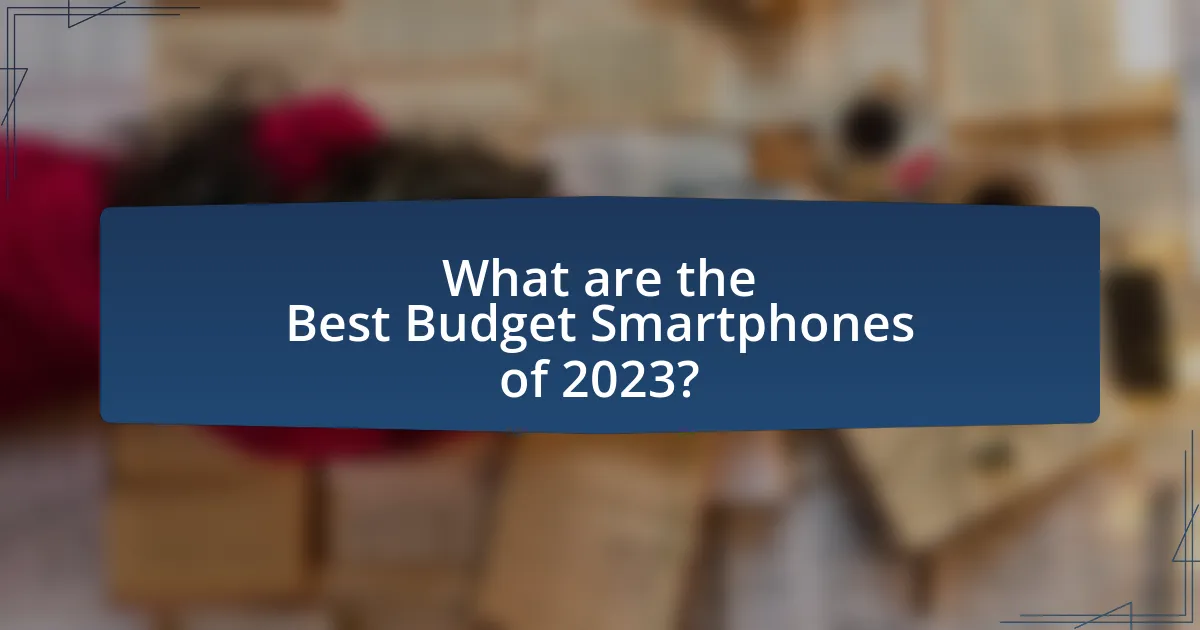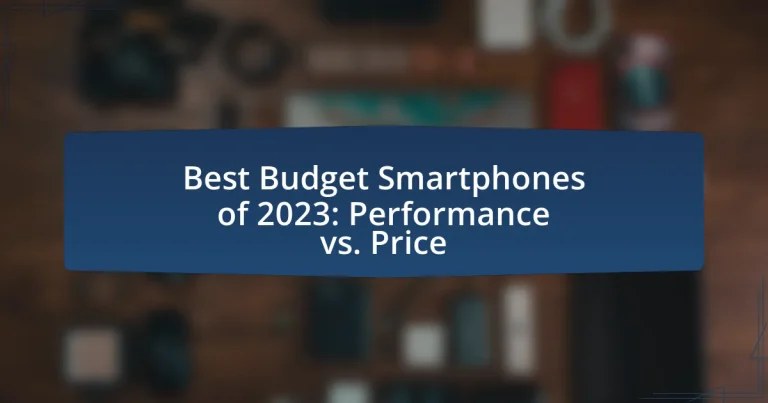The article focuses on the best budget smartphones of 2023, highlighting key models such as the Google Pixel 6a, Samsung Galaxy A53, and OnePlus Nord N20. It compares budget smartphones to flagship models, detailing the typical sacrifices in features like camera quality and processing power to maintain affordability. The discussion includes performance metrics that consumers should consider, such as processor speed, RAM, and battery life, as well as the importance of software updates. Additionally, the article addresses common pitfalls in purchasing budget smartphones and offers tips for balancing performance and price effectively.

What are the Best Budget Smartphones of 2023?
The best budget smartphones of 2023 include the Google Pixel 6a, Samsung Galaxy A53, and OnePlus Nord N20. The Google Pixel 6a offers excellent camera performance and software support at a price point around $449. The Samsung Galaxy A53 features a vibrant display and solid battery life, retailing for approximately $349. The OnePlus Nord N20 provides a stylish design and decent performance for about $282. These smartphones are recognized for their balance of performance and affordability, making them top choices in the budget category this year.
How do budget smartphones compare to flagship models?
Budget smartphones typically offer essential features at a lower price point compared to flagship models, which provide advanced technology and premium materials. For instance, budget smartphones often have lower processing power, reduced camera quality, and less durable build materials, while flagship models incorporate the latest processors, superior camera systems, and high-end displays. According to a 2023 report by Counterpoint Research, flagship smartphones have an average price of around $1,000, while budget models are priced under $300, highlighting the significant cost difference and corresponding feature disparity.
What features are typically sacrificed in budget smartphones?
Budget smartphones typically sacrifice features such as high-resolution displays, advanced camera systems, premium build materials, and powerful processors. These sacrifices are made to keep production costs low and offer a more affordable price point. For instance, many budget models use lower-resolution LCD screens instead of OLED, which affects display quality. Additionally, camera capabilities are often limited, with fewer lenses and lower megapixel counts compared to flagship models. Furthermore, budget smartphones frequently utilize plastic bodies instead of metal or glass, which impacts durability and aesthetics. Lastly, they may be equipped with less powerful processors, resulting in slower performance and reduced multitasking capabilities.
How does performance vary across different budget smartphones?
Performance varies significantly across different budget smartphones, primarily influenced by factors such as processor type, RAM, and software optimization. For instance, smartphones equipped with MediaTek Dimensity or Qualcomm Snapdragon processors generally offer better performance compared to those using lower-tier chipsets. A study by Counterpoint Research in 2023 indicated that devices with at least 4GB of RAM and optimized software can handle multitasking and gaming more efficiently, resulting in smoother user experiences. Additionally, budget smartphones with regular software updates tend to maintain performance levels over time, while others may lag due to outdated software.
Why is performance important in budget smartphones?
Performance is important in budget smartphones because it directly affects user experience and functionality. A smartphone’s performance determines how smoothly it runs applications, handles multitasking, and processes tasks, which is crucial for users who rely on their devices for daily activities. According to a study by Counterpoint Research, budget smartphones with optimized performance can significantly enhance user satisfaction, leading to higher retention rates. Therefore, effective performance in budget smartphones ensures that users can enjoy essential features without lag or frustration, making it a key factor in their purchasing decisions.
What performance metrics should consumers consider?
Consumers should consider metrics such as processor speed, RAM, battery life, camera quality, and software optimization when evaluating smartphone performance. Processor speed, measured in GHz, indicates how quickly a device can execute tasks; for example, a smartphone with a 2.0 GHz processor typically performs better than one with a 1.5 GHz processor. RAM, usually ranging from 3GB to 8GB in budget smartphones, affects multitasking capabilities; more RAM allows for smoother operation when running multiple applications. Battery life, often expressed in milliampere-hours (mAh), is crucial for daily usage; a device with a 4000 mAh battery generally lasts longer than one with a 3000 mAh battery. Camera quality, assessed through megapixels and aperture size, impacts photo clarity; a smartphone with a 12MP camera and a wide aperture captures better low-light images. Finally, software optimization, which refers to how well the operating system and applications are tailored to the hardware, can significantly enhance overall performance, making a well-optimized device feel faster and more responsive.
How do budget smartphones handle multitasking and gaming?
Budget smartphones typically handle multitasking and gaming with limitations due to their lower processing power and RAM compared to premium devices. These smartphones often feature entry-level processors and 3GB to 4GB of RAM, which can lead to slower performance when running multiple applications simultaneously or playing graphics-intensive games. For instance, many budget models struggle with demanding games like PUBG or Call of Duty Mobile, often resulting in lower frame rates and longer loading times. Additionally, multitasking may cause apps to reload frequently, disrupting user experience. Despite these challenges, some budget smartphones are optimized for casual gaming and basic multitasking, making them suitable for users with moderate demands.
What are the top contenders for budget smartphones in 2023?
The top contenders for budget smartphones in 2023 include the Google Pixel 6a, Samsung Galaxy A14, and OnePlus Nord N20. The Google Pixel 6a offers a strong camera performance and stock Android experience at an affordable price of around $449. The Samsung Galaxy A14 features a large display and solid battery life, priced at approximately $199, making it an excellent choice for budget-conscious consumers. The OnePlus Nord N20 combines a sleek design with good performance, retailing for about $299. These smartphones are recognized for their balance of performance and price, catering to users seeking quality without breaking the bank.
What specifications do these smartphones offer?
The specifications of the best budget smartphones of 2023 typically include features such as a minimum of 4GB RAM, 64GB internal storage, and a 6.5-inch display with at least Full HD resolution. Additionally, these smartphones often come equipped with multi-camera systems, including a primary sensor of 48MP or higher, and support for 5G connectivity. Battery capacities generally range from 4000mAh to 5000mAh, ensuring all-day usage. These specifications are designed to provide a balance of performance and affordability, catering to users who seek value without compromising essential features.
How do user reviews reflect the performance of these models?
User reviews reflect the performance of budget smartphones by providing firsthand accounts of user experiences, highlighting strengths and weaknesses. For instance, users often comment on battery life, camera quality, and processing speed, which directly correlate with the technical specifications and performance metrics of the models. Reviews frequently include ratings and detailed feedback that can indicate overall satisfaction levels; for example, a model with a high number of positive reviews typically showcases reliable performance in everyday tasks, while consistent complaints about lag or poor camera quality suggest performance issues. This collective feedback serves as a practical benchmark for potential buyers, allowing them to gauge how well the smartphones perform in real-world scenarios compared to their advertised capabilities.

How do Price and Performance Interact in Budget Smartphones?
Price and performance in budget smartphones are inversely related; as the price decreases, performance typically diminishes. Budget smartphones often utilize lower-cost components, such as less powerful processors and reduced RAM, which directly impacts their ability to handle demanding applications and multitasking. For instance, a budget smartphone priced around $200 may feature a processor that is significantly less capable than one found in a mid-range device priced at $400, resulting in slower performance and limited functionality. This relationship is evident in market analyses, such as those conducted by Counterpoint Research, which show that budget smartphones often sacrifice processing power and camera quality to maintain affordability, thereby influencing consumer choices based on their performance needs versus budget constraints.
What is the average price range for budget smartphones in 2023?
The average price range for budget smartphones in 2023 is between $150 and $400. This range reflects the increasing competition among manufacturers and the availability of features that were previously exclusive to higher-end models. According to market analysis from Counterpoint Research, budget smartphones have seen significant advancements in technology, allowing consumers to access quality performance at lower price points.
How does pricing affect the features offered?
Pricing directly influences the features offered in budget smartphones, as manufacturers often allocate resources based on the price point to balance performance and cost. For instance, lower-priced models typically have reduced specifications, such as less RAM, lower-quality cameras, and fewer advanced technologies like 5G connectivity. According to a study by Counterpoint Research, budget smartphones under $300 often lack features found in mid-range devices, such as higher resolution displays and faster processors, which are more prevalent in models priced above $400. This correlation between pricing and features ensures that consumers receive a product that aligns with their budget while still meeting basic functionality needs.
What are the best value options available?
The best value options available in budget smartphones for 2023 include the Google Pixel 6a, Samsung Galaxy A53, and OnePlus Nord N20. The Google Pixel 6a offers excellent camera performance and stock Android experience at a price point around $449, making it a top choice for photography enthusiasts. The Samsung Galaxy A53, priced at approximately $349, provides a balanced performance with a vibrant display and solid battery life, appealing to users seeking a well-rounded device. The OnePlus Nord N20, available for about $282, stands out with its sleek design and fast charging capabilities, catering to users who prioritize aesthetics and convenience. These smartphones exemplify the best value by delivering high performance relative to their cost, supported by positive user reviews and expert recommendations.
Why should consumers prioritize performance over price?
Consumers should prioritize performance over price because higher performance often leads to better user experience and longevity of the device. For instance, smartphones with superior processors and RAM can handle multitasking and demanding applications more efficiently, reducing lag and enhancing overall functionality. Research indicates that devices with better performance metrics tend to have longer lifespans and require fewer upgrades, ultimately saving consumers money in the long run. According to a study by Counterpoint Research, smartphones with higher performance ratings retain their value better over time, making them a more cost-effective choice despite a higher initial price.
What are the long-term benefits of investing in performance?
Investing in performance yields long-term benefits such as enhanced user satisfaction, increased device longevity, and improved resale value. High-performance smartphones typically offer faster processing speeds, better graphics, and superior multitasking capabilities, which lead to a more enjoyable user experience over time. Additionally, devices with robust performance specifications tend to remain relevant longer, as they can handle software updates and new applications more effectively. This longevity translates into a higher resale value; for instance, smartphones with better performance metrics can retain up to 30% more of their original value after two years compared to lower-performing models. Thus, prioritizing performance in budget smartphones not only enhances immediate usability but also provides financial advantages in the long run.
How can consumers assess the value of performance in budget smartphones?
Consumers can assess the value of performance in budget smartphones by evaluating key specifications such as processor speed, RAM, battery life, and camera quality. For instance, a smartphone with a quad-core processor and at least 4GB of RAM typically offers better multitasking capabilities and smoother performance compared to lower specifications. Additionally, consumers should consider user reviews and benchmark scores, which provide insights into real-world performance. According to a study by Counterpoint Research, budget smartphones with optimized software can outperform higher-priced models in specific tasks, highlighting the importance of software efficiency alongside hardware specifications.

What Should Consumers Look for When Choosing a Budget Smartphone?
Consumers should prioritize key specifications such as processor performance, battery life, camera quality, and software updates when choosing a budget smartphone. A capable processor, like the Qualcomm Snapdragon 6 series or MediaTek Dimensity, ensures smooth performance for everyday tasks. Battery life is crucial; smartphones with at least 4000mAh can typically last a full day under moderate use. Camera quality is important for capturing clear images; look for models with at least 12MP main cameras and additional features like night mode. Lastly, regular software updates enhance security and user experience, so consumers should consider brands known for providing timely updates, such as Google or Samsung.
How can consumers evaluate the performance of budget smartphones?
Consumers can evaluate the performance of budget smartphones by examining key specifications such as processor speed, RAM, storage capacity, and battery life. For instance, a smartphone with a quad-core processor and at least 4GB of RAM typically offers smoother multitasking and app performance compared to lower specifications. Additionally, consumers should consider user reviews and benchmark scores from reputable sources like Geekbench or AnTuTu, which provide comparative performance metrics. These benchmarks often reveal how budget smartphones stack up against each other in real-world usage scenarios, confirming their capabilities in handling everyday tasks and gaming.
What benchmarks are useful for assessing smartphone performance?
Useful benchmarks for assessing smartphone performance include AnTuTu, Geekbench, and 3DMark. AnTuTu provides a comprehensive score based on CPU, GPU, memory, and user experience tests, making it a widely recognized standard for overall performance evaluation. Geekbench focuses on CPU performance through single-core and multi-core tests, allowing for comparisons across different devices and operating systems. 3DMark specializes in graphics performance, particularly for gaming, by evaluating how well a smartphone can handle demanding graphics tasks. These benchmarks are validated by their extensive use in the tech community and their ability to provide quantifiable performance metrics.
How do real-world tests compare to benchmark scores?
Real-world tests often provide a more accurate representation of a smartphone’s performance compared to benchmark scores. While benchmark scores measure specific hardware capabilities under controlled conditions, real-world tests evaluate how devices perform in everyday scenarios, such as app loading times, multitasking, and gaming. For instance, a smartphone may achieve high benchmark scores due to its powerful processor but may lag in real-world usage if its software optimization is poor. Studies have shown that user experience can differ significantly from benchmark results, highlighting the importance of considering both metrics when assessing smartphone performance.
What are the common pitfalls to avoid when buying budget smartphones?
When buying budget smartphones, common pitfalls to avoid include overlooking performance specifications, neglecting software updates, and ignoring build quality. Performance specifications, such as processor speed and RAM, directly impact user experience; for instance, a smartphone with less than 4GB of RAM may struggle with multitasking. Neglecting software updates can lead to security vulnerabilities and outdated features; many budget smartphones receive limited support, which can hinder long-term usability. Lastly, ignoring build quality can result in a device that is prone to damage; budget smartphones often use cheaper materials that may not withstand daily wear and tear.
How can consumers identify misleading marketing claims?
Consumers can identify misleading marketing claims by critically evaluating the language used in advertisements and seeking third-party reviews. Misleading claims often use vague terms like “up to” or “best,” which can be deceptive. For instance, a smartphone advertised as having “the best battery life” may only achieve that under specific conditions not disclosed in the marketing. Additionally, consumers should look for independent reviews and comparisons that provide factual performance data, as these sources can clarify the actual capabilities of a product. Research indicates that 70% of consumers trust online reviews as much as personal recommendations, highlighting the importance of verifying claims through credible sources.
What are the signs of a low-quality budget smartphone?
Signs of a low-quality budget smartphone include poor build quality, low-resolution displays, inadequate processing power, limited RAM, and subpar camera performance. Poor build quality often manifests as flimsy materials that can easily break or scratch, while low-resolution displays result in a lack of clarity and vibrancy. Inadequate processing power and limited RAM lead to sluggish performance, making multitasking difficult. Additionally, subpar camera performance is characterized by low megapixel counts and poor low-light capabilities, which diminish the overall user experience. These factors collectively indicate that a smartphone may not meet the standards expected for reliable performance and usability.
What tips can help consumers make the best choice for their needs?
To make the best choice for their needs, consumers should prioritize key features such as performance, battery life, camera quality, and software updates when selecting a budget smartphone. Evaluating performance involves comparing processors and RAM specifications, as these directly impact speed and multitasking capabilities. Battery life is crucial; consumers should look for devices with at least 4000 mAh capacity to ensure longevity throughout the day. Camera quality can be assessed through reviews and sample images, focusing on megapixels and additional features like night mode. Lastly, considering the frequency of software updates is essential for security and access to new features, with brands like Google and Samsung often providing better support. By focusing on these aspects, consumers can align their choices with their specific usage needs and preferences.
How can consumers balance performance and price effectively?
Consumers can balance performance and price effectively by conducting thorough research on specifications and user reviews before making a purchase. This approach allows consumers to identify smartphones that offer the best features for their budget, ensuring they do not overspend on unnecessary capabilities. For instance, a study by Counterpoint Research in 2023 indicated that mid-range smartphones, priced between $300 and $600, often provide performance comparable to flagship models, making them a cost-effective choice for consumers seeking value without sacrificing quality.
What resources are available for comparing budget smartphones?
Resources for comparing budget smartphones include websites like GSMArena, which provides detailed specifications, user reviews, and comparison tools. Additionally, YouTube channels such as MKBHD and Unbox Therapy offer video reviews and comparisons that highlight performance and price. Tech blogs like Android Authority and CNET also publish articles that analyze budget smartphones, comparing features, performance metrics, and pricing. These resources collectively provide comprehensive insights and data for consumers looking to evaluate budget smartphones effectively.





